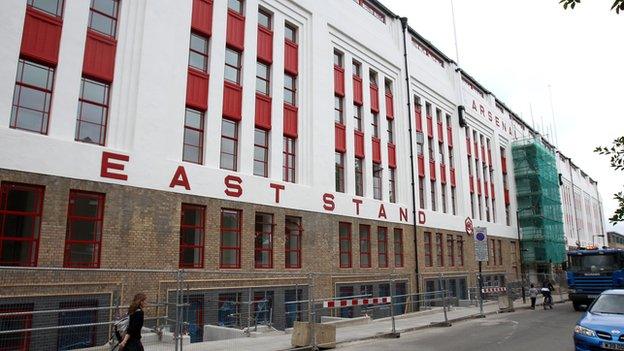Remembering Middlesbrough's move to the Riverside
- Published
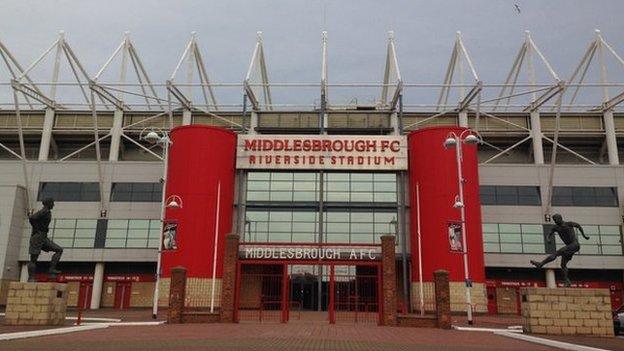
The old gates from Ayresome Park were moved to the main entrance of the Riverside
Twenty years after Middlesbrough left Ayresome Park, fans, players and management remember the move to the Riverside.
When referee Paul Vanes blew the final whistle in Middlesbrough's 2-1 win over Luton Town, he brought to an end 92 years of football at Ayresome Park.
The victory on 30 April 1995 effectively won Bryan Robson's Boro the First Division championship and promotion to the Premier League.
And for their return to the top flight, Middlesbrough had a new home: the Riverside, built in the Middlehaven area on the south bank of the Tees.
The time was right for the move.
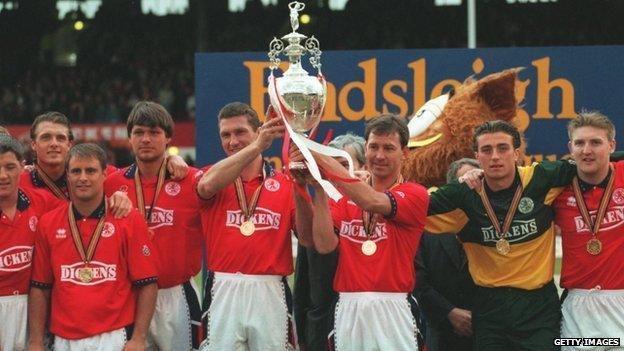
Player-manager Bryan Robson led Middlesbrough to the First Division title in the club's last season at Ayresome Park
The Taylor Report - commissioned after the deaths of 96 Liverpool fans at Hillsborough in 1989 - was making all-seater stadiums compulsory in the top two divisions.
Bringing Ayresome Park up to standard would have cut the ground's capacity by more than 6,000 to 20,000, upset the neighbours and been poor investment for a club which had narrowly avoided financial collapse just nine years earlier.
And the Teesside Development Corporation (TDC), which hoped to make the stadium the flagship of their docklands redevelopment, had secured government funding to install the roads, drainage and utilities, leaving the club to pay for just the stadium itself.
Ron Norman, chairman of Teesside Development Corporation said: "We saw it as morale for the area. We needed something to lift spirits and we saw relocation of the football as an opportunity to do that."
The Riverside, with a capacity of more than 30,000, external, was the first stadium to be built after the Taylor Report and took just 32 weeks to complete for a cost to the club of £16m.
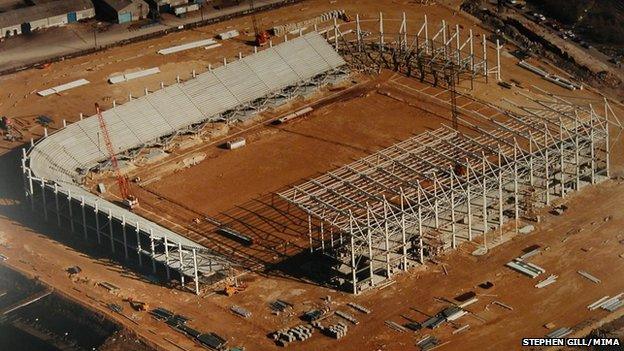
The infrastructure around the stadium was paid for by government funding, leaving the club to pay £16m for the stadium itself
Keith Lamb, chief executive of Middlesbrough from 1986 to 2011, said: "We knew all-seater stadiums were on the horizon and the cost of redeveloping Ayresome Park was just going to be too much for very little return.
"There was a lot of criticism of a proposed redevelopment of Ayresome Park, particularly from neighbours concerned with noisiness. We had a good relationship with residents but they were delighted to see us go."
But the decision was not popular with all.
Chairman Colin Henderson feared the deal would put the club back into debt.
And fans were also upset at the thought of leaving their much-loved ground, which had hosted three games in the 1966 World Cup.
Rob Nichols, editor of Middlesbrough fanzine Fly me To The Moon, said: "It was tremendous sadness leaving the ground but we knew something had to happen because of the Taylor Report.
"As the plans developed people got excited, although they didn't believe the new ground would actually be open on time.
"The move was inevitable in the end. Putting seats in the Holgate End stand, for example, would have killed Ayresome in the way we remember it; the atmosphere would have changed."
The final match at Ayresome was a day of mixed emotions.
Mr Nichols, who now lives on the housing estate built on the site of the former stadium, said: "Everyone was wearing red. You had a carnival atmosphere with all the old players there.
"The match itself turned out to be a bit of a struggle. You worried if everything that had gone on had put them off."
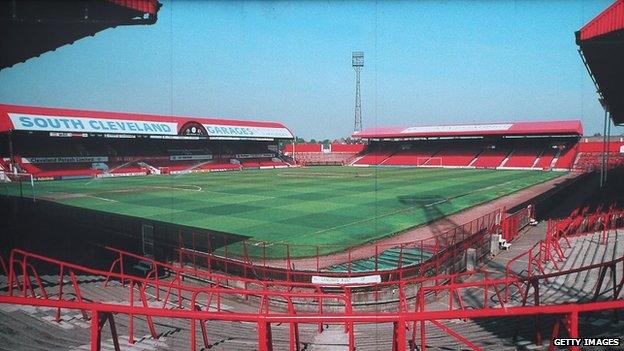
Ayresome Park was Middlesbrough's home from 1903 to 1995
Two goals from John Hendrie won the game and defeat for Bolton several days later ensured Middlesbrough won the title.
Hendrie said: "It was like a theatre. We had an opera singer come in and the old players were there.
"Because of all the hype there was more pressure on us to perform. It was a great day - you could see a sea of red around the ground."
He said Ayresome Park was an intimidating ground for visiting teams.
"As a home player, the pitch was brilliant but the ground was getting a bit run down and it was time to move on," he said.
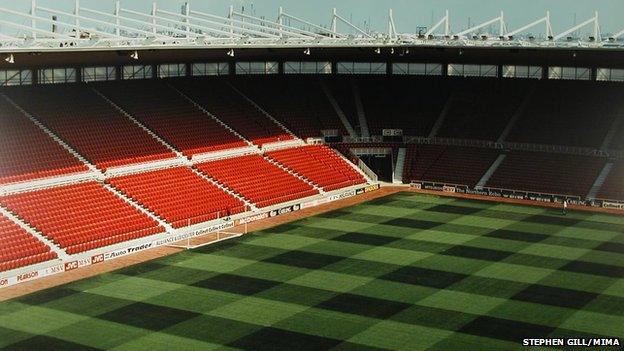
There were fears the stadium would not be ready in time for Boro's first home game of the 1995/96 Premier League season
Craig Hignett did not play in the last game at Ayresome but went on to write his name in the club's history books by scoring Boro's first goal at the Riverside.
He said: "Ayresome was really tight. You could hear people shouting at you - if you were having a bad game you would know about it.
"It needed updating; it would have cost a fortune, it wasn't in the best location. If we got in the Premier League it would have been chaos around there and residents wouldn't have taken kindly to it."
And 119 days later, Middlesbrough were kicking off their first game at the Riverside against Chelsea in the Premier League in front of 28,286 fans.

John Hendrie scored the last goal at Ayresome Park, his second in a 2-1 win over Luton Town
John Hendrie said: "We went at various times to see the ground taking shape. It was awesome.
"Going to a brand spanking new place with all mod cons was terrific. It had to be done, certainly the club wouldn't have blossomed as much at old Ayresome Park as it has at the Riverside."
Mr Nichols said walking into their new stadium and finding their new seats was a surreal experience for many fans.
He said: "The fans were all swan-necking. It was like walking into Wembley - our jaws were on the floor."
After 39 minutes at the new ground, Hignett scored from a Nick Barmby cross, Boro's first goal in a 2-0 win over Chelsea.
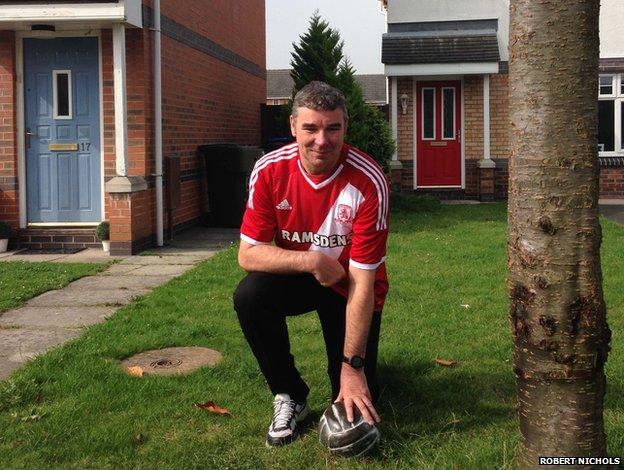
Rob Nichols bought one of the houses built on the site of Ayresome Park where one front garden has a sculpture marking the position of one of the penalty spots
Hignett said: "We weren't sure it would be ready. We trained on it the day before. We still had to wear hard hats around the place and it still hadn't been signed off for its safety certificate.
"We were assured that, come Saturday, the game would go ahead.
"Coming out to see the stadium full was something I will never forget. It took on another level. I thought, 'If I've got to play in this every week I've got to bring my proper game.' I didn't want to embarrass myself in front of all those people.
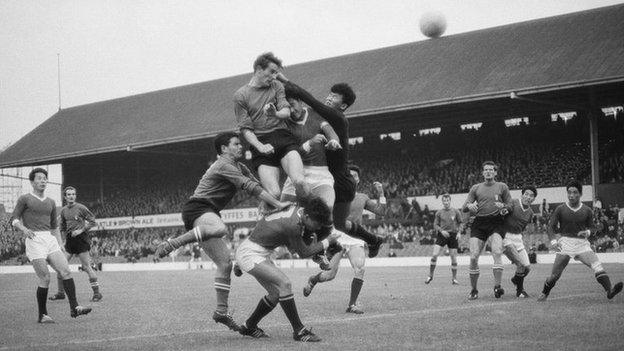
Ayresome Park hosted three games at the 1966 World Cup, all three featuring North Korea including their shock 1-0 win over Italy
"The club went massive in the space of six months."
Since their move, Middlesbrough have suffered two relegations, external from and one promotion to the Premier League, won the 2004 League Cup, external and finished runners-up in the 2006 UEFA Cup, external.
The stadium has also hosted England Under-21 internationals, the last of which - a 3-2 friendly win against Germany - saw a record attendance for a junior international away from Wembley, and Great Britain's warm-up matches ahead of the 2012 Olympics.
Mr Nichols said: "Some games we have seen at Riverside are beyond anything that I experienced at Ayresome Park."
A special hour-long documentary marking Middlesbrough's move has been created by BBC Tees.
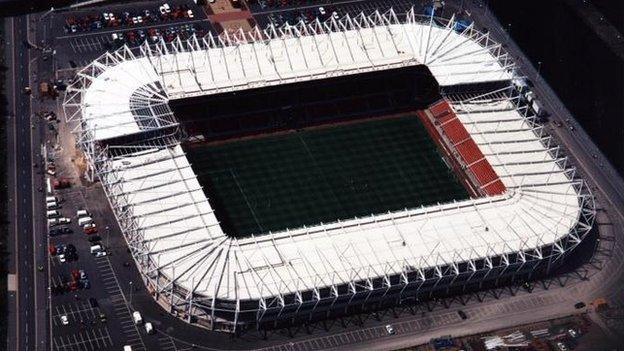
The Riverside stadium has hosted European matches, warm-up games for the 2012 Olympics and England Under- 21s
- Published8 February 2015

- Published21 October 2014
